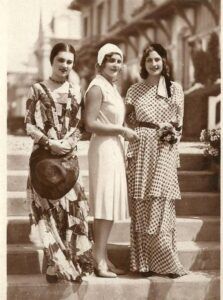A striking photo is a powerful thing. The right image can change minds, tug at heartstrings, illicit anger and prompt tears. Pictures are potent; communicating in seconds what might take a writer hundreds of words. They document our past, keep us apprised about our present and, sometimes, inform the future.
They can also lie.
Photos have also been one of the most effective propaganda tools for those wishing to smear Israel, with such images now frequently “going viral” on social media.
A case in point illustrating this fact came last week when a Facebook user posted a black and white image of three women alongside the caption: “Miss Palestine with her two Runners-up in 1947. Very fashionable and celebration without fear!”
It quickly garnered hundreds of likes and shares, while comments included: “The most important thing without fear. Totally different from the time we live in unfortunately,” and “The era of ancient history and civilization before its desecration.”
However, a reverse image search on Google reveals the shot actually depicts competitors in the Miss Europe pageant in 1930 and the women are from Russia, Austria and Holland. The picture was featured on a postcard by Alfred Noyer, a French photographer who worked out of his studio in Paris up until the 1940s.

While this may not be the most egregious example of spreading falsehoods through the medium of photography, it is emblematic of the problem in which images are used as vehicles to misrepresent the truth about the Israeli-Palestinian conflict.
The term “Pallywood” – a portmanteau of Palestinian and Hollywood – was coined by Richard Landes, who produced a short documentary film in 2005 that demonstrated that photographs and footage are routinely manipulated to push anti-Israel propaganda.
Focusing on the now-discredited footage of 12-year-old Gazan boy Muhammed al-Durrah, Landes argued news reporters are all too willing to unquestioningly disseminate certain items without bothering to check their veracity.
The 11-day Hamas-initiated conflict this year saw a flurry of misleading and outright fake images posted online, most of which were used to discredit or defame Israel and its citizens.
A notable example of this was the infamous photos and video that purported to show ultranationalist Israelis dancing and celebrating at the Western Wall while flames rip through the Al-Aqsa mosque in the background.
After being shared online in May, the imagery went viral as thousands of people shared their disgust, including Israeli parliamentarian Ayman Odeh, a member of the Joint List alliance, who tweeted it alongside the caption, “shocking.”
Yet, the truth, which was ignored by those who had uncritically shared it online, was that the orange licks of fire were from a tree that had been set alight by Palestinian protesters lobbing firecrackers at police. Furthermore, the “extremists” who were supposedly gleefully cheering the destruction of the Islamic holy site were simply Jews celebrating Jerusalem Day.
Another photo that was soon shared far and wide around the same time was of a little girl, who users claimed had been killed in an Israeli airstrike on Gaza.
Tweeting an image of the toddler, one user stated: “None of the human race will drop an explosive fire on this innocence. This beautiful child was torn in pieces today. Her beauty squeezes hearts with pain. #GazaUnderAttack.”
None of the human race will drop an explosive fire on this innocence.
..
This beautiful child was torn in pieces today
Her beauty squeezes hearts with pain
..
#Gaza_Under_Attack pic.twitter.com/zmU4zGIP12— Asmaa Ghalwa (@AsmaaGhalwa) May 14, 2021
Fact-checkers quickly debunked it, sharing proof the image was of a Russian child living in Moscow. Unbeknownst to the girl’s mother, it had been stolen from her Instagram account and used to perpetuate the ancient blood libel that Jews are child killers.
In late May, uninformed social media users branded IDF soldiers vicious monsters after photos surfaced of a woman carrying a young child being led away by men in military fatigues.
Numerous Twitter users shared the pictures accompanied by various claims, the most prominent of which was that soldiers were “abducting and raping” Palestinian women.
Yet again, a reverse image search revealed the truth.
The woman was not being led away to be brutally violated by Israeli soldiers. She was instead identified as Lama Khater, a Palestinian journalist who was being arrested at her home in Hebron in 2018 for her alleged involvement in Hamas terror activities.
THEY ARE ABDUCTING WOMEN AND RAPING THEM…Why no one can see their suffering ???They are so helpless even the thought of all this is enough for me to go in trauma for lifetime…THIS NEEDS TO STOP #FreePalestine pic.twitter.com/YVyTp1NdC1
— Mahnoor (@zalimduniya14) May 23, 2021
Alarmingly, it is not just ill-informed netizens who carelessly spread images that serve to bolster a false narrative.
The New York Times, for example, was forced to issue a correction on May 31 after it published a photo of a girl, who it claimed was Palestinian airstrike victim Rahaf al-Masri.
However, the photographer who snapped the sweetly-smiling girl soon set the record straight: it was actually of a child named Salma and was taken in 2015 in Ramallah, in the West Bank.
The aforementioned are just a few examples of how imagery has been used to manipulate and misinform, but they serve as a reminder of why it is so important to take nothing at face value — especially when it relates to Israel and Palestinians.
A picture tells a thousand words, as the famous proverb goes. Whether those words bear any semblance to the truth is another matter entirely.
Liked this article? Follow HonestReporting on Twitter, Facebook, Instagram and TikTok to see even more posts and videos debunking news bias and smears, as well as other content explaining what’s really going on in Israel and the region.



